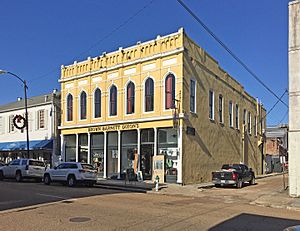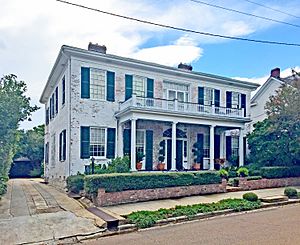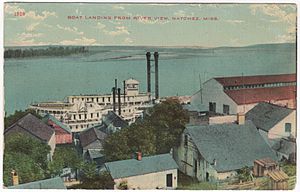Norman Studio facts for kids
The Norman Studio was a famous photography business. It was run by a father and son, Henry C. Norman (1850—1913) and Earl Norman (1888—1951). Their studio was in Natchez, Mississippi, United States. They took pictures from 1876 to 1951.
They created about 75,000 images. These photos show many important events and people. They documented life in small towns along the lower Mississippi River. Their collection is one of the most important visual records of Southern American life. It covers the late 1800s and early 1900s.
The Norman Studio's photos show how Natchez grew. Natchez was a very successful city in Mississippi. Their work covers periods like Reconstruction, the Gilded Age, and the Progressive Era. It also shows some of the Jazz Age and the Great Depression. Today, these photos are kept at Louisiana State University libraries. They are part of the Lower Mississippi Valley Collection.
Contents
How the Norman Studio Began
The Norman Studio's story started even before the American Civil War. It was founded by two brothers, Henry D. Gurney and Marsh Gurney. They were among the first photographers to live and work in Mississippi. They started their business in Natchez in 1851. This was only 12 years after photography was invented in France by Louis Daguerre.
The Gurney brothers came from Massachusetts. They quickly became successful. Henry Gurney earned a lot of money by 1860. Sadly, Marsh died in 1858 from yellow fever. Natchez was lucky because it was not destroyed during the American Civil War (1861—1865). Most other cities in the American South were badly damaged.
This good fortune likely brought Henry C. Norman to Natchez. He was 20 years old when he arrived by steamboat in 1870. He came from Louisville, Kentucky. Before that, he and his mother had moved from Georgia. His father, Joshua, had died in 1865. Henry Norman found a job at Gurney's studio. In 1876, Gurney retired, and Norman bought the business. This included all of Gurney's photography equipment.
Henry Norman's Photography Work
Henry Norman quickly became a very busy photographer. People from all over the lower Mississippi Valley wanted his pictures. His wife, Clara, helped him. They set up their studio in downtown Natchez. It was on the second floor of a nice brick building on Main Street.
Henry was very skilled with his camera. For 35 years, he took pictures of many people and events. He photographed both white and African-American citizens. He was famous for his portraits. But Henry Norman did more than just studio work. He often took his camera outside.
He captured real-life moments. He photographed people in the streets or working hard. He took pictures of children playing or resting by the Mississippi River. He also documented bad weather, like floods near the Natchez wharf. He photographed factories and businesses around Natchez. Exciting daily events were also his subjects. He captured trains arriving at the Yazoo and Mississippi Valley Railroad station. He also photographed important visitors, like President of the United States William Howard Taft in 1909. Henry Norman often used a Kodak Century camera.
Henry and Clara Norman had three sons. All of them became photographers. Only the youngest son, Earl, born in 1888, stayed to work with his father. When Henry died in July 1913 at age 62, Earl took over the studio. Earl was only 25 years old. For the next 38 years, Earl continued his father's work. He ran the studio until his own death in 1951.
Saving the Norman Studio Collection
After Earl Norman died, his glass negatives and prints were left unprotected. They sat on a brick patio for almost ten years. They were exposed to the weather and collected dust. Then, in 1960, a doctor from Natchez named Thomas H. Gandy and his wife Joan bought them. They also bought the remaining photography equipment from Earl's widow.
This was a very important moment for the Norman Studio's history. The Gandys loved preserving local history. They were very involved in saving Natchez's historic buildings. They helped start the Historic Natchez Foundation. This group still works to preserve the city's history today.
The Gandys began the hard work of cleaning the items. They had to figure out which ones could still be used. About 20 percent of the collection was too damaged to use. But the other four-fifths were an amazing collection of images. The Gandys used the Normans' old appointment books to find dates for portraits. They also asked older Natchez residents to help identify people in the photos.
They chose the best photos and published them in several books. These books came out in the 1970s and 1980s. The Gandys gave some of the collection to Louisiana State University in Baton Rouge. Thomas Gandy had gone to LSU. After their books were published, they donated the rest of the collection to LSU. As of 2018, LSU libraries have put some of these photos online. You can view them there.
There is also a permanent exhibit of about 500 Norman Studio photos. It is at Stratton Chapel at Natchez’s First Presbyterian Church. This church is at the corner of Pearl and State streets. The exhibit is open to the public regularly.
What the Collection Shows
The Normans and Gurneys photographed all parts of life in and around Natchez. Their photos show many different things. They include wide views of the town from the steeple of St. Mary's (Catholic) Cathedral. They also show parties on barges and steamboats on the Mississippi River. There are pictures of stores and buildings.
You can see workers moving crops with animals. There are photos of local college baseball teams. The collection also shows disaster relief after floods. You can see hired workers in cotton fields. There are pictures of everyday street activity and people playing card games.
Steamboats and River Life
Some of the most important parts of the collection are the steamboat pictures. These boats were very important for the region's economy. They helped Natchez recover after Reconstruction. They also helped Natchez stay an important city into the 1900s.
Steamboats were common in the middle of America during the Victorian and Edwardian eras. But many of these boats were never photographed. The Normans' photos are sometimes the only pictures of them. Steamboats often had accidents or disasters. They might only last a few years.
The Norman Studio photographed many kinds of steamboats. These boats used the Natchez landing. Some were small family boats that served local farms. Others were regional lines with a few boats. These boats traveled several times a week to cities like Vicksburg, Greenville, Bayou Sara, and St. Joseph, Louisiana. There were also huge, fancy boats from big companies like the Anchor Line. These traveled regularly between New Orleans and St. Louis or Cincinnati.
Henry C. Norman was often invited onto these ships. He photographed the fancy and simple cabins, dining rooms, decks, engine rooms, smokestacks, and crews. Before the Natchez-Vidalia Bridge was built in 1940, the Normans also photographed the ferryboats and tugs. These boats connected the towns on both sides of the Mississippi River.
Buildings and Towns
The collection also shows many buildings in Natchez. Many of these buildings have changed a lot over the years. Some have been changed, torn down, or destroyed by disasters. The Norman Studio's photos are often the only visual record of them.
This includes pictures of the former city of Bayou Sara, Louisiana. This city was south of Natchez. It was abandoned in 1927. This happened after many floods, like the Great Mississippi Flood of 1927. Living along the river became too difficult, so people moved to higher ground in St. Francisville.
Photography Techniques Used
The Norman Studio used many different photography methods as the art changed over time. These include:
- Daguerreotypes
- Ferrotypes
- Wet and dry glass-plate collodion negatives
- Film negatives




